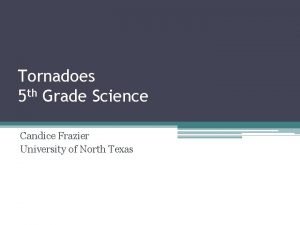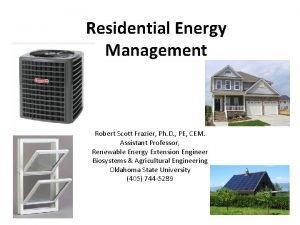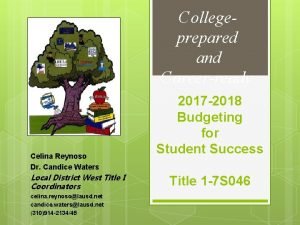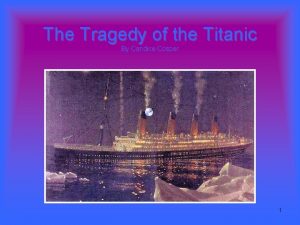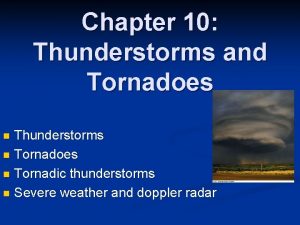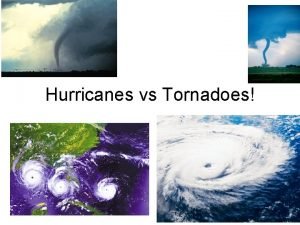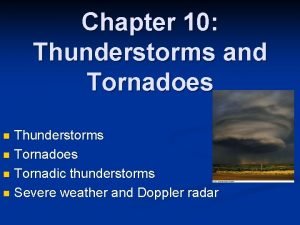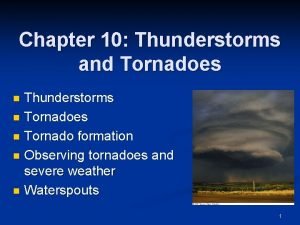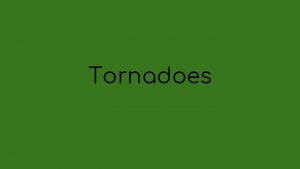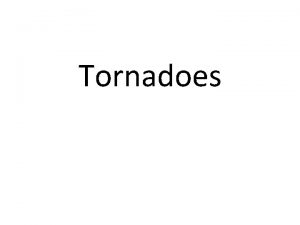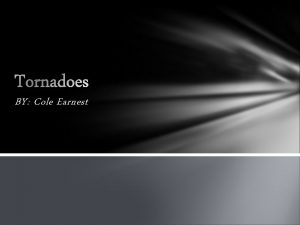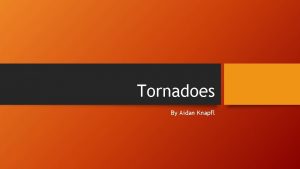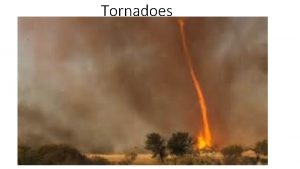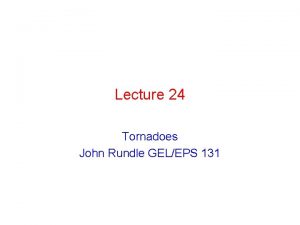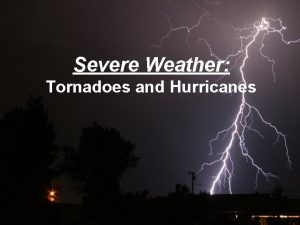Tornadoes 5 th Grade Science Candice Frazier University












- Slides: 12

Tornadoes 5 th Grade Science Candice Frazier University of North Texas

Teks v § 112. 7. Science, Grade 5 • (4)Science is a way of learning about the natural world. Students should know how science has built a vast body of changing and increasing knowledge described by physical, mathematical, and conceptual models. • (3) Scientific processes. The student uses critical thinking and scientific problem solving to make informed decisions. The student is expected to: (C) represent the natural world using models and identify their limitations • (5) Science concepts. The student knows that a system is a collection of cycles, structures, and processes that interact. The student is expected to: • (A) describe some cycles, structures, and processes that are found in a simple system; and • (B) describe some interactions that occur in a simple system. • (6) Science concepts. The student knows that some change occurs in cycles. The student is expected to: • (A) identify events and describe changes that occur on a regular basis such as in daily, weekly, lunar, and seasonal cycles

5 th Graders • I will be teaching this lesson plan to 5 th graders. • They will come from all types of backgrounds and will be at different levels on where they stand with science. -Due to this, I will take this lesson slow and make sure that it is fun, yet teaches them the concepts of tornadoes and why they happen.

What is a tornado? • Tornado: is a violent rotating column of air extending from a thunderstorm to the ground. • The most violent tornadoes are capable of tremendous destruction with wind speeds of up to 300 mph. • They can destroy large buildings, uproot trees and hurl vehicles hundreds of yards. They can also drive straw into trees. • Damage paths can be in excess of one mile wide to 50 miles long. • In an average year, 1000 tornadoes are reported nationwide.

How Do Tornadoes Form? • Most tornadoes form from thunderstorms. • You need warm, moist air from the Gulf of Mexico and cool, dry air from Canada. When these two air masses meet, they create instability in the atmosphere. • A change in wind direction and an increase in wind speed with increasing height creates an invisible, horizontal spinning effect in the lower atmosphere. • Rising air within the updraft tilts the rotating air from horizontal to vertical. An area of rotation, 2 -6 miles wide, now extends through much of the storm. • Most strong and violent tornadoes form within this area of strong rotation.

Tornado Formation

Tornado Activity: Tornado Bottles • Materials Needed: 2 2 -litre pop bottles washed and dried. 1 1 -inch metal washer duct tape to secure the two bottles together Process: Fill one of the bottles with water about 2/3 full. Place the metal washer over the opening of the bottle. Turn the second bottle upside down and twist it onto the metal washer. Use the duct tape to keep the two bottles in place making sure that no water can leak out. Now turn the bottle so that the bottle with the water is on top and swirl it in a circular fashion to make a tornado inside a bottle.

Tornado Alley

Group Activity • Divide the class into groups of five students each. • Ask groups to imagine that they are safety engineers who have been asked to do consulting work for the town council of a small city in Tornado Alley( Texas being part of Tornado alley, students are able to relate. ) • Have each group prepare a report listing simple steps people could take to lessen the damage caused by small flying objects during a tornado. • Invite the groups to present their reports to the “council” (the class).

FUJITA SCALE OF TORNADO INTENSITY Rating Wind Speed Damage F-1 73 - 112 mph Rips shingles off roofs; flips mobile homes. F-2 113 - 157 mph Upturns and flips boxcars. F-3 158 - 206 mph Exterior walls and roofs blown off homes. Metal buildings collapsed or severely damaged. Forests and farmland destroyed. F-4 207 - 260 mph Few walls left standing. Large concrete blocks launched far distances. F-5 261 - 318 mph Homes flattened with all debris removed. Schools, motels, and other larger structures damaged considerably with exterior walls and roofs gone. Top floors demolished.

Evaluation v. Have them write a paper based on: • Fujita Scale of Tornado Intensity. • How and why Tornadoes occur. • What they learned overall about Tornadoes. • What they thought about the Tornado Bottle Activity and the group activity.

References • http: //school. discoveryeducation. com/lessonpla ns/programs/ragingplanet-tornado/ • http: //www. weatherwizkids. com/weathertornado. htm
